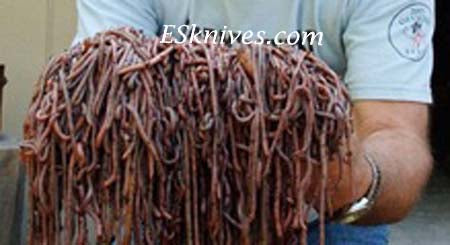Charming the Fiddle Worms - Fishing Bait
Fiddle worms make excellent bait for catfish, bass, bream, and trout. They are especially valuable because of their length: One worm, broken apart, will easily fill several hooks, and the worms are tough enough to stay securely in place. Charming worms is a southern tradition. Fiddling is still used in certain parts of the southeastern U.S. today, though it probably reached its peak during the 1960’s. Charmers are hard to find now a days.
In North Alabama this is how many of us catch our own bait. Where I come from Fiddling worms is considered a art. First time I saw worm fiddling was when I was around 10 years old. I was a city boy and we were vising my Uncle and Aunt on top of Brindlee Mountian in North Alabama, the foothills of the Appalachian Mountains. My Uncle showed my dad and I how it was done. In minutes we had a bucketful of worms, ready to go fishing.

My Uncle got us a bucket of worms with nothing more than an old rusty handsaw missing a few teeth and a bucket. He told us that the best time to go worming is in the spring but I have found that you can capture worms any time of the year, unless the ground is frozen.
There have been studies that confirmed worm grunters (another name for fiddling) have actually been tricking these worms into thinking they are being chased by its primary predator; moles. That’s why they appear above the ground almost like magic. They are in fear for their lives and quickly crawl from their burrows to escape.
Here is how we do it:
The success of worm charming can often depend on soil conditions, with charmers choosing damp locations or using water to attract the worms. A crucial factor in finding a good site to "play up" the worms is to have good moisture in the soil. Fiddle worms like the earth damp. In dry weather they move down into the lower parts in search of water. The first thing is to look for is good soil.
When you've located an area you believe there may be worms, begin to look for worm casings. Worm casing is another term or worm poop, which are small, round casings that the worms discharge as they munch on the soil. Casings can be found easily among decaying leaves at the base of a young trees.
Once you have found a small sapling, around three inches in diameter, it is time to start fiddling. Cut your sampling and leave around 18" for a the stump. Before you go out cutting peoples trees down, ask for permission.
Take an old wood saw, that the teeth have been dulled, and start fiddling by simply dragging the cutting edge back and forth across the top of the stump. The vibrations that are created travel down the tree's root system, sending tremors down into the earth that jolt the worms to the surface. In good damp ground you'll start seeing worms in five minutes maybe sooner. Dryer soil will take longer. Give it at least 10 minutes before looking for a new site. Just keep playing and worms should appear, they might be as far as 25-30 feet away. Fiddle worms on an average are between 12 and 15 inches long.
When your worms begin to surface, collect them in a bucket. Make sure your bucket has some holes. You don't want your worms to drown. Fill your bucket with dirt. You can keep them in the bucket for up to two months. Keep them watered which means keep them moist. Throw in a little cornmeal every once in a while.
If you can't find a worn out saw, there are other methods of fiddling for bait. Instead of a saw you can use a metal bar and instead of a sapling you can use a wooden stake. Find a roughly 3-foot long wooden stake and pound it about halfway into the ground. Take a piece of flat, or round iron, roughly half as long as the stake and run it across the stake. You'll have to lean into it because you want those vibrations to go deep into the ground. This method will get good results.
There is a technique that involves a chainsaw. Take the chain off your chainsaw. Start your chainsaw and hold it against the ground. This usually brings up buckets of worms. A friend gave me a long metal pole that you plug in and shove it in the ground. I don't know if it works but I have it. I have known people to take a big rock and hit their sapling stump over and over to get worms. This technique is a little to rough for me.
Whatever technique you use it is best to start around sunrise. After 11:00 it is time to give up. My experience has been that temperature does not matter but the ground can't be frozen. You can sprinkle your spot with with water, tea or even beer for a slight edge. Some grunters poke their area with a pitchfork before fiddling. The point is to start fiddling, practice, experiment and create techniques that work for you.

Don't worry about having to many worms. Bait shops and fishing camps love to buy fiddle worms. You may be able to sell the leftovers. 25 worms in a large Styrofoam cup, a few contacts and you are on your way to worm profits. Get the whole family involved. Kids love to fiddle worms. Bring several buckets.
In North Alabama this is how many of us catch our own bait. Where I come from Fiddling worms is considered a art. First time I saw worm fiddling was when I was around 10 years old. I was a city boy and we were vising my Uncle and Aunt on top of Brindlee Mountian in North Alabama, the foothills of the Appalachian Mountains. My Uncle showed my dad and I how it was done. In minutes we had a bucketful of worms, ready to go fishing.

My Uncle got us a bucket of worms with nothing more than an old rusty handsaw missing a few teeth and a bucket. He told us that the best time to go worming is in the spring but I have found that you can capture worms any time of the year, unless the ground is frozen.
There have been studies that confirmed worm grunters (another name for fiddling) have actually been tricking these worms into thinking they are being chased by its primary predator; moles. That’s why they appear above the ground almost like magic. They are in fear for their lives and quickly crawl from their burrows to escape.
Here is how we do it:
The success of worm charming can often depend on soil conditions, with charmers choosing damp locations or using water to attract the worms. A crucial factor in finding a good site to "play up" the worms is to have good moisture in the soil. Fiddle worms like the earth damp. In dry weather they move down into the lower parts in search of water. The first thing is to look for is good soil.
When you've located an area you believe there may be worms, begin to look for worm casings. Worm casing is another term or worm poop, which are small, round casings that the worms discharge as they munch on the soil. Casings can be found easily among decaying leaves at the base of a young trees.
Once you have found a small sapling, around three inches in diameter, it is time to start fiddling. Cut your sampling and leave around 18" for a the stump. Before you go out cutting peoples trees down, ask for permission.
Take an old wood saw, that the teeth have been dulled, and start fiddling by simply dragging the cutting edge back and forth across the top of the stump. The vibrations that are created travel down the tree's root system, sending tremors down into the earth that jolt the worms to the surface. In good damp ground you'll start seeing worms in five minutes maybe sooner. Dryer soil will take longer. Give it at least 10 minutes before looking for a new site. Just keep playing and worms should appear, they might be as far as 25-30 feet away. Fiddle worms on an average are between 12 and 15 inches long.
When your worms begin to surface, collect them in a bucket. Make sure your bucket has some holes. You don't want your worms to drown. Fill your bucket with dirt. You can keep them in the bucket for up to two months. Keep them watered which means keep them moist. Throw in a little cornmeal every once in a while.
If you can't find a worn out saw, there are other methods of fiddling for bait. Instead of a saw you can use a metal bar and instead of a sapling you can use a wooden stake. Find a roughly 3-foot long wooden stake and pound it about halfway into the ground. Take a piece of flat, or round iron, roughly half as long as the stake and run it across the stake. You'll have to lean into it because you want those vibrations to go deep into the ground. This method will get good results.
There is a technique that involves a chainsaw. Take the chain off your chainsaw. Start your chainsaw and hold it against the ground. This usually brings up buckets of worms. A friend gave me a long metal pole that you plug in and shove it in the ground. I don't know if it works but I have it. I have known people to take a big rock and hit their sapling stump over and over to get worms. This technique is a little to rough for me.
Whatever technique you use it is best to start around sunrise. After 11:00 it is time to give up. My experience has been that temperature does not matter but the ground can't be frozen. You can sprinkle your spot with with water, tea or even beer for a slight edge. Some grunters poke their area with a pitchfork before fiddling. The point is to start fiddling, practice, experiment and create techniques that work for you.

Don't worry about having to many worms. Bait shops and fishing camps love to buy fiddle worms. You may be able to sell the leftovers. 25 worms in a large Styrofoam cup, a few contacts and you are on your way to worm profits. Get the whole family involved. Kids love to fiddle worms. Bring several buckets.

Related Posts
-
Weekly Knife Giveaway - Claim your Entry
We're giving away a knife every week through the end of A...
-
Survival with Bandanas
When I am out in the wild for more than a day I always th...








Comments